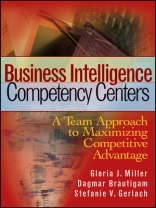Transform data into action for competitive advantage
‘The knowledge assets of an organization are becoming increasingly
important for competitive advantage, and therefore, the way in
which knowledge is created, renewed, and communicated is critical.
This book provides practical insights into how this may be achieved
through the establishment of a Business Intelligence Competency
Centre and is a valuable read for ‘information
professionals.”
–Bill Sturman, Information Architecture Project Manager The Open
University, United Kingdom
‘BI is more than technology and projects. BI must live in the
organization–as a BICC. This book helps to make BI tangible and
understandable, bringing it to life.’
–Miriam Eisenmann, Project Manager (PMP) CSC Ploenzke AG,
Germany
‘This book is a must-read for planning and implementing your BICC.
It is a pragmatic guide that addresses a lot, if not all, of the
questions you’ll be asking yourself. Don’t miss out on getting a
head start from the people who thought this through from start to
finish . . . Pray your competitors don’t get hold of this
book!’
–Claudia Imhoff, President Intelligent Solutions, Inc., USA
‘Creating a BICC forces the organization to focus on the importance
of centralizing the gathering, interpreting, and analyzing of
information to create business insight.’
–Anne Ulyate, Group Manager Business Intelligence Mutual &
Federal, South Africa
‘BI is a highly visible element in the ‘business value’ trend for
IT investments. Initiatives, such as competency centers, should
empower user organizations to drive even more value out of their BI
investments.’
–Marianne Kolding, Director, European Services IDC, United Kingdom
İçerik tablosu
Foreword.
Preface.
Acknowledgments.
Chapter 1: Introduction.
Overview.
Business Intelligence as a Competitive Differentiator.
Business Intelligence Competency Center.
Summary.
Chapter 2: Business Intelligence in the Organization.
Overview.
General Findings of the Survey.
Business Intelligence Competency Centers.
Summary.
Chapter 3: Primary Functions of the Business Intelligence
Competency Center.
Overview.
Functional Areas Inside the BICC.
Detailed Checklist for the Functional Areas in the BICC.
Related Functional Areas.
Summary.
Chapter 4: Planning a Business Intelligence Competency
Center: Using the Information Evolution Model.
Overview.
Four Critical Dimensions of the Information Evolution Model.
Five Levels of Maturity in the Information Evolution Model.
Defining the BI Strategy.
Summary.
Chapter 5: Human Capital.
Overview.
Staffing the Business Intelligence Competency Center.
Summary.
Chapter 6: Knowledge Processes.
Overview.
Knowledge Processes in the Business Intelligence Competency
Center’s Functional Areas.
Summary.
Chapter 7: Culture.
Overview.
Organizational Setup and Funding.
Performance Metrics.
Knowledge Management.
Change Management.
Summary.
Chapter 8: Infrastructure.
Overview.
Considerations from a BICC Perspective.
Business Intelligence Infrastructure Selection Criteria.
Road Map to Implementing a BI Infrastructure.
Summary.
Chapter 9: Setting Up and Ensuring Ongoing Support.
Overview.
Setup Process in Detail.
Working with Software Vendors.
Summary.
Chapter 10: Cases from the Field.
Insurance, South Africa: Mutual & Federal Defines Business
Intelligence Strategy.
Public Administration, Italy: CSI-Piemonte Manages Growth with a
Business Intelligence Competency Center.
Banking, Belgium: KBC Benefits from an SAS Business Intelligence
Competency Center.
Banking, South Africa: Competency Center Drives Return on BI
Investments at Nedbank.
Summary.
Chapter 11: Ten Recommendations for a Highly Effective
Business Intelligence Competency Center.
Have a Vision for Business Intelligence.
Create a Joint Venture Between Business and Information
Technology.
It’s a Process, Not a Project.
Maintain Clear Vision, Concrete Objectives.
Integrate and Consolidate.
Practice Effective Change Management.
Carry Out Staff Induction, Training, Development.
Deliver Ongoing Value.
Ensure the Infrastructure’s Depth and Breadth.
Use a Multidimensional Approach.
Appendix A: List of Abbreviations.
Appendix B: Additional Roles.
Index.
Yazar hakkında
Gloria J. Miller, Vice President, Professional Services Division, SAS International, heads the international Professional Services Division at SAS, is the Executive Manager for the development of SAS Industry Intelligence Solutions, and is on the board of directors of SAS Global Services. Throughout her career of more than eighteen years in the information technology industry, Miller has received accolades for her skills in the management and delivery of IT systems and programs and in software development and support. She holds a master’s degree in business administration from Bowie State University in Bowie, Maryland, and a bachelor of science degree from Augusta State University in Augusta, Georgia.
Dagmar Bräutigam, Professional Services Program Manager, SAS International, has led the development of the Business Intelligence Competency Center Program and the Information Evolution Assessment Service. Based in Heidelberg, Germany, she is responsible for creating, developing, and rolling out SAS’s education and consulting programs and services for the SAS Europe, Middle East, Africa, and Asia/Pacific regions. Bräutigam studied translation sciences in Heidelberg, London, and Geneva, and holds a degree from Ruprecht-Karls-University of Heidelberg.
Dr. Stefanie V. Gerlach, Senior Program Consultant, SAS International, has extensive experience in developing training programs for project teams and business users. She developed the Business Intelligence Competency Center initiative for SAS and is responsible for the Business Intelligence Competency Center Services for the SAS Europe, Middle East, Africa, and Asia/Pacific regions. Gerlach has studied political science, history, and Protestant theology in Heidelberg and Paris, and holds a Ph D in political science from Ruprecht-Karls-University of Heidelberg. Gerlach also codeveloped a manual that describes training methods and how to implement and manage computer training.
SAS Institute (Cary, NC) is the market leader in providing a new generation of business intelligence software and services. SAS solutions are used at more than 40, 000 sites, including ninety-six of the top 100 companies on the Fortune Global 500®. SAS has customers in 110 countries.












